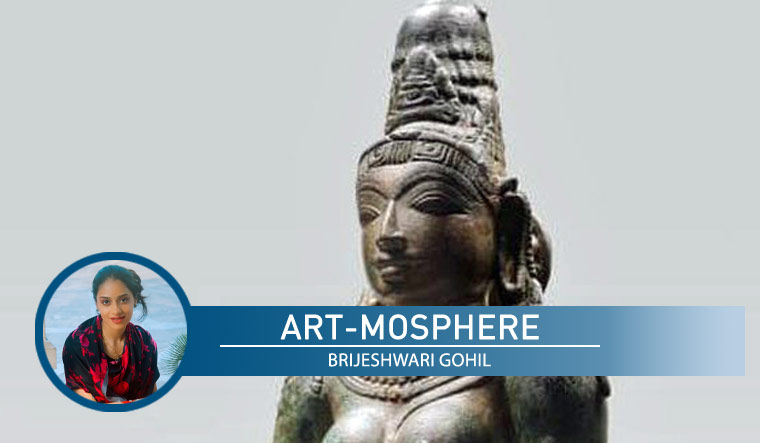India’s leading auction houses conclude their annual Spring Auction. The season seems to have gone well for most, with modern and contemporary works of art appreciating in leaps and bounds. On the other hand, Indian antiques are rarely seen at auctions in India. This could be the result of several nuances stemming from the historic laws that continue to govern antiques in India.
In a country where ancient civilisations have flourished, art has evolved and changed in each region of this culturally diverse nation. Art movements have come and gone. But we are still disorganised where regulation and purchasing of antiques is concerned. The art buyer and collector partaking in an auction in India seldom finds antiquities. Be it the historic, finely detailed miniature paintings, manuscripts, the stone and bronze idols and statues or the works by Orientalists and Bombay Art Society’s great maestros. Age-old laws and unfavourable regulatory systems have stifled and stunted the market for antiquities to grow and flourish.
Section 19 of the Antiquities and Art Treasures Act 1972 states that, “if the Central Government is of opinion that it is desirable to preserve any antiquity or art treasure in a public place, that Government may make an order for the compulsory acquisition of such antiquity or art treasure”.
This draconian law has led to an atmosphere of fear and apprehension amongst antique owners. Further, the restricted market has led to illicit trade of antiquities since decades. As a result, art works lose their provenance and value, auction houses end up being sceptical to place them in an auction with poor provenance and this vicious, hindering cycle continues.
The majority of antiques pre-Independence would have belonged to nobility and royalty or been treasured objects in places of worship. For example, the guarded treasure trove at Padmanabhaswamy Temple. While I could understand the lack of know-how on selling these works of art shortly after Independence, it truly surprises me that in a time and age where documentation and valuation are given such impetus, a flourishing black market is still the preferred option.
Are collectors, who have owned these object of art as part of their family collections for decades if not a century, considering a sale through an unlicensed entity as a better option? Is it easier to sell antiques in a manner where no questions are raised or attention diverted to a family? Or does a lack of knowledge still prevail?
I recall reading about a medieval period Lord Vishnu statue that was being sent through a regular courier service and had been listed as a new statue in 2021. Upon reaching Bengaluru, the officer in charge noticed the statue had suffered oxidisation: Testimony to the statue being an antique. He immediately seized the object, not allowing its export.
I wonder how many such fine works of art would have been sold undocumented, for measly sums of money.
A few years ago, the Piramal Museum of Art, Mumbai, organised a conference on Art Laws in India, which I was lucky to participate in. The conference included the many issues India faces when it comes to creating a transparent, legitimate antiquity market. Strangely enough, these discussions reminded me of the liquor ban in Gujarat. Alcohol prohibition in the state leads to innumerable alcohol poisoning deaths every year and a thriving market of bootleggers. It is human nature, similar to that of a rebellious child, that when people are not given the freedom to make informed choices, they break the law.
Smugglers have prospered while antique works have lost their cultural and monetary value. The most notorious player in this field has been Subhash Kapoor, who is accused of smuggling objects worth over 150 million dollars.
In 2007, the Archaeological Survey of India, launched the National Mission for Monument and Antiquity, a database to protect antiques from being smuggled. However, in over 15 years, the database has only managed to record a mere 16.8 lakh antiquities. Hoping to change the scenario is Asign, a recently launched website, which aims to create an art community, ‘a software for art with multiple functionalities’, according to its director Ashvin E. Rajagopalan.
After extensively surveying the art ecosystem, Ashvin took on the mammoth task of building an accessible portal which aims to systemise the sector, “unlocking its potential value”, he states.
There is no single platform that can synthesise art institutions, professionals, students and seekers. Not only would such an endeavour help with transaction of art, creating a marketplace like Amazon, but it would simultaneously build a repository of information which would be accessible to all. The lack of accessibility to archives and collections is a constant challenge almost every researcher in the art sector faces. Be it an art historian with decades of experience or an art student completing his or her preliminary college project.
We live in an era where the digital world is transforming lives, be it through accessibility or connectivity. This also leads to the constant fear of data leaks and security. If the legendary British Library can be hacked, any and every archive, collection, website and software can in my opinion. Trusting a website and adding data from your collection and creating a registry on a digital platform can be daunting and invasive to some. Be it a government-run one or a private portal. Especially to the quiet, publicity averse private collectors. Many of whom may not particularly like to look at art from a transactional standpoint. However, on the flip side, most of us are sharing our lives on social media rather aimlessly and without much purpose.
With better laws in place and an accessible platform such as this, there would be transparency of information, authenticity of art and in due time an exciting antiquity auction to look forward to.


